March 8, 2013
Air Date: March 8, 2013
FULL SHOW
SEGMENTS

The Team to Tackle Climate
View the page for this story
President Obama announces three nominations for his Green Team and roster of climate change fighters. Mindy Lubber, former EPA administrator and president of CERES, and Adam Kolton, Director of Advocacy at the National Wildlife Federation, join host Steve Curwood to discuss the picks. (12:15)
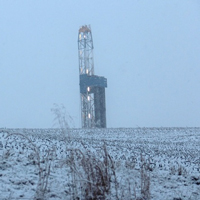
Fracking on Amish Land
/ Reid FrazierView the page for this story
Amish communities live a simple life, and mostly shun modern technology. But in Carroll County, Ohio, many Amish farms sit on top of rich gas shale beds, and most Amish there welcome fracking, and its rewards. Reid Frazier reports. (08:00)

Keystone XL Pipeline Report
View the page for this story
The State Department recently released a new environmental impact assessment of the Keystone XL Pipeline. The assessment argued that the project would not significantly affect the development of the Canadian Tar Sands, nor would it have great overall environmental impact. Steve Kretzmann of Oil Change International tells host Steve Curwood the report is misleading. (06:25)
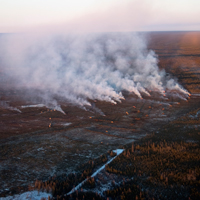
Canadian Government Gag Order for Scientists?
View the page for this story
Canada's Harper Administration is allegedly restricting what environmental information government scientists can share with journalists, according to academics and media watchdogs. Host Steve Curwood learns more from Tyler Sommers, coordinator of Democracy Watch. (06:30)

Road Salt Report
/ Ashley AhearnView the page for this story
Every year, the nation uses more than 20 million tons of salt to clear snow and ice from winter roads. While it may make the roads safer, scientists say salt may have the opposite effect on drinking water and wildlife. Ashley Ahearn reports. (05:25)

The Hazards of Plastic Waste
View the page for this story
Some scientists have called for reclassifying plastic as a hazardous waste. This would give environmental agencies more tools and funding to clean up plastic in ecosystems around the world. One of the authors of a commentary in Nature is Chelsea Rochman, an marine ecologist at the University of California at Davis. She tells host Steve Curwood about the dangerous pollutants inside many plastic products. (06:15)
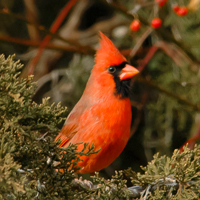
The Cardinal's Growing Range
/ Mark Seth LenderView the page for this story
The brilliant red plumage of the Cardinal is now a common sight throughout New England. But as writer Mark Seth Lender observes, this is a new development and due to the shift in climate that has warmed the region. (02:10)
Show Credits and Funders
Show Transcript
Host: Steve Curwood
Guests: Mindy Lubber, Adam Kolton, Steve Kretzmann, Tyler Sommers, Chelsea Rochman
Reporters: Reid Frazier, Ashley Ahearn, Mark Seth Lender
[THEME]
CURWOOD: From Public Radio International, this is Living on Earth. I'm Steve Curwood. The President has chosen much of his new team to take on climate change, and activists are cheering the pick for the EPA.
LUBBER: She is fair, she is smart, and she knows how to play the games that seem to be played in Washington. I can think of no better person for President Obama to be nominating.
KOLTON: We certainly agree. I mean, this is a very strong pick. This shows the President's commitment to tackling the climate crisis.
CURWOOD: That doesn't mean confirmation will be easy though. Also, why some Amish farmers are leasing their land for natural gas fracking.
GARCZYK: They’re allowing this to go on because it benefits them too. They’ve got mortgages and they’re paying their bills and farming with the money they’ve received from the oil and gas business.
CURWOOD: That and more this week, on Living on Earth. Stick around.
[THEME]
[MUSIC: Boards Of Canada “Zoetrope” from “In A Beautiful Place Out In The Country” (Warp Records 2000)]
ANNOUNCER: Support for Living on Earth comes from Stonyfield Farm.
The Team to Tackle Climate
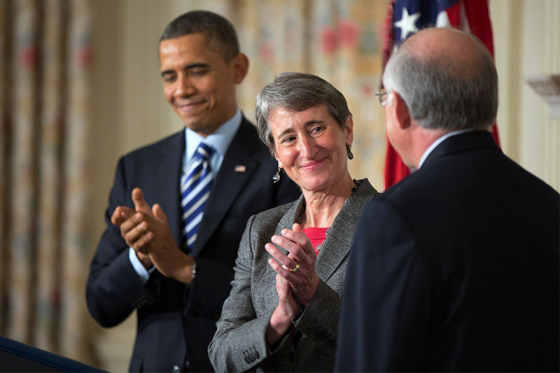
Sally Jewell, Secretary of Interior-designate. President Obama at left, outgoing Interior Secretary Ken Salazar with back to the camera. (Photo: Pete Souza)
CURWOOD: From the Jennifer and Ted Stanley Studios in Boston, this is Living on Earth. I’m Steve Curwood. To help keep his promise to tackle climate change in his second term, President Obama has nominated three key cabinet officers. The President wants EPA air chief Regina McCarthy to lead the Agency, and former Energy Department Undersecretary and MIT physicist Ernest Moniz to be Secretary of Energy. An avid hiker and former petroleum engineer has been tapped to be Secretary of the Interior. She's Sally Jewell, who is now CEO of REI and a vice chair of the National Parks Conservation Association. For some insight, here's Mindy Lubber, a former Regional EPA administrator and president of CERES, and Adam Kolton, Director of Advocacy at the National Wildlife Federation. Welcome to Living on Earth!
LUBBER: Steve, it's always nice to be here. Thanks for having me.
KOLTON: Thanks for having me on, Steve.
CURWOOD: Mindy, let me start with you. You worked with Gina McCarthy when she was an environmental advisor to Massachusetts governors, including Mitt Romney. How do you think she’s going to do as head of the EPA?

EPA Administrator-designate Gina McCarthy (photo: Environmental Protection Agency)
LUBBER: You know, I worked with Gina McCarthy when she worked as a regulator in Massachusetts, when she worked for a Republican governor, when she worked for a Republican governor in Connecticut and when she worked for a Democratic president of the United States. And the reason I mention those partisan titles - not because I think we should be concerned about them - is because it speaks to Gina’s strength. She can work with anyone, Republicans and Democrats, business people and advocates. She is fair. She is smart. She is focused, and she wants to get the job done. And she knows how to play the games that seem to be played in Washington. I can think of no better person for President Obama to be nominating.
CURWOOD: Adam Kolton?
KOLTON: We certainly agree. I mean, this is a very strong pick, and I think together with some of the other nominations, including Senator Kerry at State, this shows the President’s commitment to tackling the climate crisis and continuing work, the foundation laid in the first term. Certainly somebody who has a proven track record of actually tackling climate change with the historic agreement on fuel economy standards that she played an enormous role in helping broker with industry support, with union support, with environmental support. So this is someone who is absolutely qualified and we look forward to her leadership at EPA.
CURWOOD: How tough is she? I mean the EPA is right in the sights of the Republican majority of the House. Industry is very concerned about any kind of climate regulation. She'll be writing the regulations that would presumably rein in existing power plants, a point of great contention. How is she going to be able to handle that pressure?
LUBBER: You know, she is tough, to answer your question, but at the same time she is fair. Let’s look at an example. Gina McCarthy was responsible, of course, with the President of United States behind her, in taking our fuel economy standards from 27 miles per gallon to 54. That's terrific, and all parties stood by it. The key magic there was - and of course there's no magic, but the strength of Gina McCarthy - was finding an outcome that got the job done. It took an enormous amount of emissions out of the air, and did so in a way that was good for the economy because we’re finding that the US-based auto companies profit more from strong fuel economy standards, and it was a proposal that industry, environmentalists, and the labor community liked. How do you get better? I think she can do that with present and future utility facilities.
CURWOOD: Adam, how you think her confirmation process will go there?
KOLTON: Well, we're hopeful. You're not to find a more experienced, more fair-minded person to head the agency. And, obviously, the President...usually there's some acknowledgement that the President gets to put his team on the field. So you know, the fact that she's determined with the President, to address climate crisis, shouldn’t be a reason for people to oppose her, but nevertheless, obviously with the controversy around the EPA, we’re certain there will be those who will oppose her in Congress, and it’s important that everybody who cares about conservation and the environment make sure to make their voices heard in that process and lend their support.
CURWOOD: Briefly, the biggest challenge for Gina McCarthy in this second term of President Obama?
LUBBER: Well, I think Adam just said it. There are all eyes on the Environmental Protection Agency, so there may very well be anger and protestations having nothing to do with Gina and much more to do with the agency. But let's just quickly understand; the EPA,while some seem to be gunning for it, is the very agency that delivers clean air and clean water to all of our families. And it ought not to be a right wing, left wing, right coast, left coast, Republican, Democrat.. We've got to turn the conversation around. The EPA's about making my kids safe and your kids safe. And I think that's what every single one of us want. Gina is the right person to make sure the EPA does that and does it well.
CURWOOD: To move onto one of the other picks, Adam, what do you think about the nomination Sally Jewell as Secretary of Interior?
KOLTON: This is a tremendous pick because, you know, we've...obviously our public lands are not just...there’s a lot of attention oftentimes in the fact that there’s oil and gas drilling and mining and logging and other activities on our public lands. But they’re also just cherished by millions of Americans for hunting and fishing and hiking and biking and kayaking and all those outdoor experiences. And that’s not important to our health and recreation as Americans, but it’s a huge business. I mean, this is a $646 billion dollar industry fueled in terms of economic activity, $49 billion in tax revenue generated. So a pick like someone who has headed REI and understands that linkage to our economy from protecting our natural resources is a very innovative and exciting pick.
CURWOOD: Not to mention somebody who can hike probably longer than the two of us put together right?
KOLTON: [LAUGHS] And climb and do a lot of other things, absolutely.
LUBBER: Certainly better than me!
CURWOOD: But consider this...before she was president of Recreational Equipment International, REI, she worked for Mobil oil. And, of course, a big role of the Interior Department is to regulate oil and gas drilling. How do you think Sally Jewell is going to handle that?
LUBBER: I think her experience in the private sector, both at Mobil, as well as running a major company and building it and making it profitable and delivering jobs is exactly what’s going to make her effective in this role. She knows how to build things. She understands multidisciplinary issues. She understands how to bring people together. I think it's terrific that she worked at Mobil. I may not choose to work there, but she understands the needs of the industry, and she's also proven to understand the needs of wilderness, and what all of us want from the beautiful open space that we love to take advantage of.
CURWOOD: OK, she cares about the outdoors. She's worked in oil. The logic says that it’s awfully difficult to do oil responsibly in the high Arctic. Shell Oil just retreated from there. How do you think Sally Jewell is going to approach regulating Shell and the other companies who want to drill in the Arctic? Adam?
KOLTON: Well, let’s just acknowledge that Shell has pulled back from plans to pursue drilling this summer, which makes sense since they've had some some significant difficulties. I think that we’re hopeful that Sally Jewell and the President will recognize that drilling in the Arctic, outer continental shelf, is a risk that ought not to taken. And that's not the direction the Administration’s been going thus far; but it's absolutely the wrong course. There’s too much at risk as we learned with the BP Deepwater Horizon oil spill. We have yet to really make all the corrections and reforms we need to ensure that spills like that don't happen again, but we’ve not come even close to figuring out how to even deal with the oil spill in extreme weather conditions in the Arctic. We're confident that she'll take the time; she'll have to get under the hood of this issue and really understand it. And again, with her background in the industry she should understand that the industry itself doesn't have the proper solutions to contain or clean up a spill. We don’t have any Coast Guard facilities in the high Arctic. So we're hopeful with the new Secretary of the Interior we can make the case anew.
CURWOOD: Let’s talk about Ernest Moniz. He’s an MIT professor who has been nominated now to be Secretary of Energy. Mindy Lubber, what about Professor Moniz? A number of environmental groups are concerned about his support for nuclear power.

Secretary of Energy-designate Ernest Moniz (photo: MIT )
LUBBER: So let me first say I have got something on my colleague - Adam Colton who’s on the other end of the line - and that is, Adam, we now have two out of three of these who are from Massachusetts, my home town. So it says something. But moving on from where they hail from, I think Ernest Moniz above all else understands that climate change is the problem of our time; that we must deal with and we must mitigate now sooner rather than later. And I think everything else he considers falls under that umbrella. Now we of course share that. We've got to address climate change. The Department of Energy has a very clear role in doing it, as does EPA, frankly as does Interior, so I think Ernest Moniz frames everything within “we’ve got to mitigate the problem of climate change” and then you work down from there. He's a strong supporter, an avid supporter, of energy efficiency, of solar energy, and of wind energy. He does believe that natural gas should be a bridge fuel, and it may very well be the reality we're facing. But I don't think he believes we should have natural gas without dealing with the environmental problems of contamination from fracking or emissions from flaring. I think he knows those things have to be regulated. As it relates to nuclear power, where you started this question, he does believe in nuclear power. I, a bit less so. But I don't think he believes in nuclear power at all costs. I think he believes in starting with renewables and efficiency and that's where it has to begin.
CURWOOD: What does it say that 2 out of 3 of these nominees have been in a number two or number three position in the agencies or departments that they’re now taking over? Mindy?

NWF’s Adam Kolton (photo: Adam Kolton)
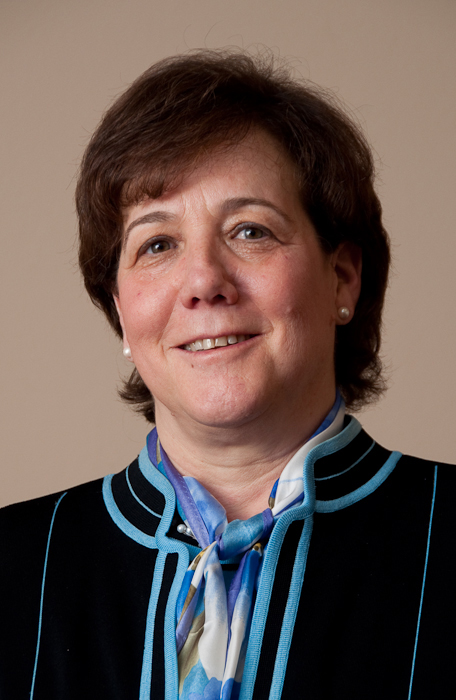
Ceres President Mindy Lubber (photo: CERES)
LUBBER: Well, it shows that in the second term of an administration, the real heavy hitters aren't taking these jobs. I couldn't disagree with that more. Knowing how to make progress in getting things done in Washington take some experience in Washington. That's not to say I’d like to see people who have lived their life there and had their careers entirely Washington-based. And Ernie Moniz had both Washington experience and academic experience; Gina McCarthy much experience at the state and even the local level. But you need people who can hit the ground running, who you could give a problem to understand how to move a massive agency. EPA is 18,000 people. How do you bring people together? How you make something happen? And I think there's actually nobody better to do that than people who have been in that number two or number three role and who have had to produce in the past. It takes a long time for a new person in Washington to figure out the rules of the game. And when it comes to climate change we don't have any time to waste.
CURWOOD: So Adam, what do you think here? What kind of team do these appointments add up to? How quick do you think the President is going to be to take on climate change and the other environmental issues during his second term with these folks leading his green team?
KOLTON: Well, we’re optimistic because there’s a lot of work to do. And the President has said some really farsighted things about his determination to address climate change, and that is in the wake of Superstorm Sandy. More and more Americans have woken up to this as a problem. We can’t hit the snooze button on any longer. This is the team to help the President advance that agenda. We can’t waste a minute. And we’re looking forward to a smooth confirmation so we can start moving forward.
CURWOOD: Adam Kolton is the Director of Advocacy at the National Wildlife Federation. Mindy Lubber is President of CERES. Thank you both for joining us.
LUBBER: Thank you, Steve, good to be here.
KOLTON: Thanks, Steve.
Related links:
- CERES website
- National Wildlife Federation
- Ernest Moniz faculty page at MIT
- Gina McCarthy’s webpage at EPA
- http://www.whitehouse.gov/blog/2013/02/06/president-obama-names-sally-jewell-lead-department-interior
CURWOOD: Just ahead...the future of the Keystone XL pipeline. Stay tuned to Living on Earth.
[MUSIC: Donald Fagan “Slinky Thing” from Sunken Condos (Reprise Records 2012)]
[CUTAWAY MUSIC: Jimi Hendrix: “Villanova Junction Blues” from People, Hell And Angels (Sony Music 2013)]
Fracking on Amish Land
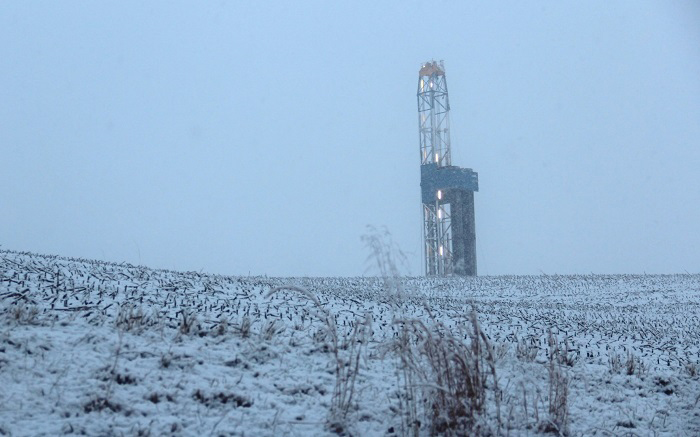
A gas rig in the winter. Carroll County, Ohio (photo: Reid Frazier)
CURWOOD: It’s Living on Earth, I'm Steve Curwood. Electricity, TV, the internet. The Amish generally live without these technologies, preserving a traditional way of life. But some Amish are saying yes to one very modern, very industrial technology: hydraulic fracturing or fracking for natural gas. In Ohio, some of the best pockets of oil and gas in the East run right under Amish country. The Allegheny Front’s Reid Frazier found the drilling is already changing the way some Amish there live.
FRAZIER: It’s an overcast day in Carroll County, Ohio, in the Southeast part of the state. An Amish farmer - dark wide brimmed hat, long beard, buttonless overcoat - is at work on his hillside farm. He mans the seat of what he calls his ‘hired hand’. It’s a skid steer loader, a kind of mini bulldozer he uses to haul huge piles of feed corn around his dairy farm.
[SOUND OF STEER LOADER]
FRAZIER: The Amish stay away from modern technology - but they do make some exceptions, and this diesel powered machine is one example. He was able to buy the machine with a new source of money - royalties. He leased his land for drilling a few years ago - he only got $15 an acre back then. But two years ago, Chesapeake Energy drilled a well on a neighbor’s farm. At around 7,000 feet down, the drill bit turned sideways, and went underneath his farm, following an oil and gas rich rock called the Utica shale. Soon after, he began receiving royalties - he won’t say how much.
The farmer, following the beliefs of most Amish, wouldn’t allow his voice or name to be used on the radio. But off tape, he said he saw no problem leasing his land for drilling. In his slight German accent, he says, The land was made for people to use.
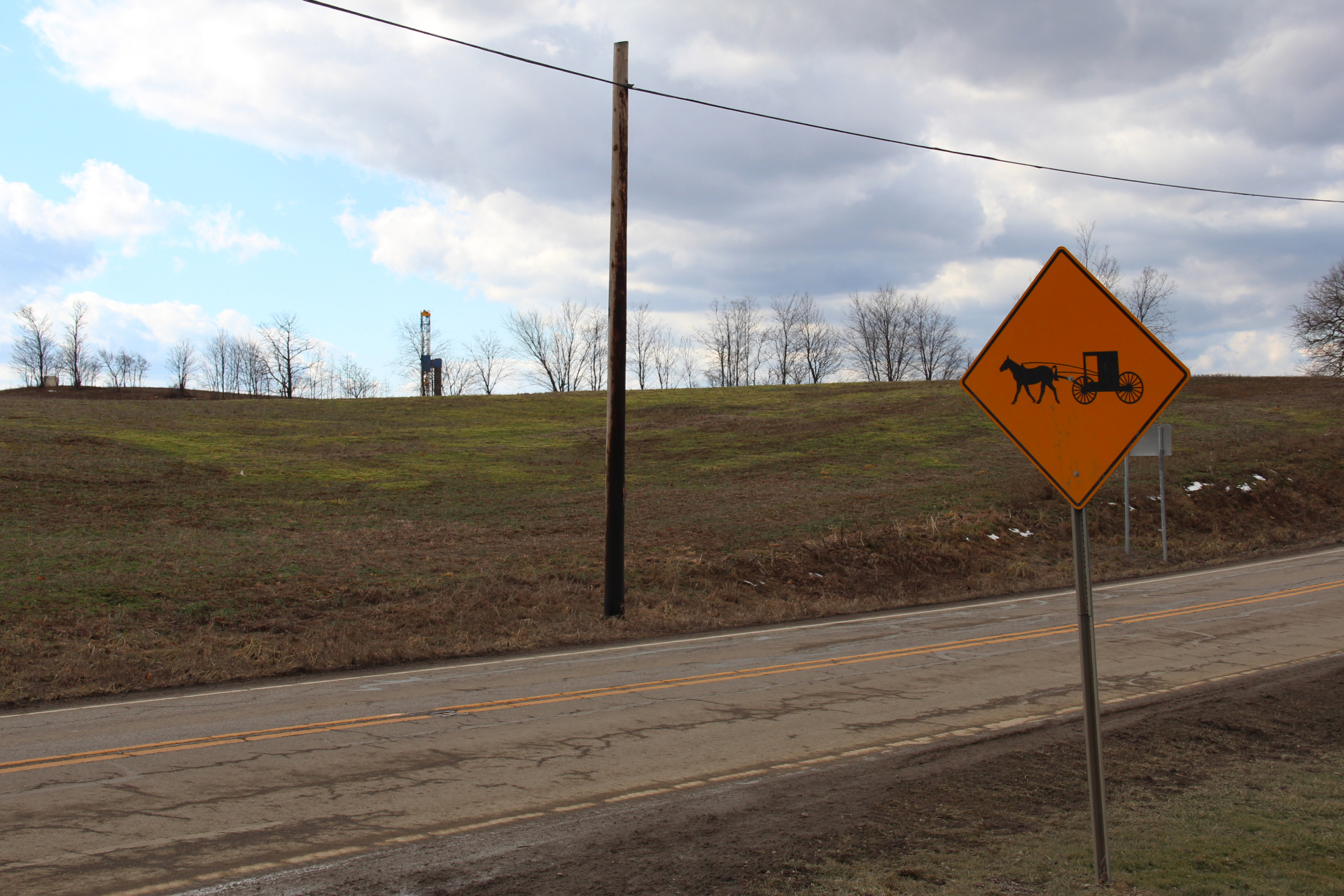
A Chesapeake drilling rig peaks over the horizon in Carroll County, Ohio (photo: Reid Frazier)
Many of his Amish neighbors feel the same way, and have leased their land for drilling. Rigs continue to migrate into this rural county - there are no four lane highways here, hardly any water and sewer services, and you can forget about most cell phone coverage. Drilling represents a whole new source of income for the Amish, says Tom Wheaton. He’s a Carroll County commissioner.
WHEATON: I’d like to see how they’re going to handle it because it makes a major change for peoples’ lives.
FRAZIER: Case in point, one Amish dairy farmer. He’d been making $40,000 a year from farming.
WHEATON: And his first royalty check was for $80,000 - in one month.
FRAZIER: There is worry this kind of money could have a corrupting influence. As the Amish farmer with the new skid steerer says, Love of money is the root of all evil. And even if you didn’t want it, Ohio law makes it very hard to keep the industry from drilling under your land, if your neighbors want to drill on theirs. In those cases, the state can mandate your land be included in a drilling unit.
Because of this, and simple economics, drilling is here to stay in Carroll County. It’s got the most oil and gas permits of any county in Ohio. Everyday, it seems, more and more trucks hauling sand, water, and equipment crowd into the streets of the county seat, Carollton.
[CARS DRIVING ON DOWNTOWN STREETS]
It’s music to the ears of Amy Rutledge. She’s the director of the county’s Chamber of Commerce and visitors bureau. It’s been good for her, personally - she was working part time before the drilling started in 2011. Now she’s full time.
RUTLEDGE: You see hope in people’s eyes again, where it had gotten pretty depressed around here.
FRAZIER: Rutledge has seen the small Amish community grow since it started coming here in the 1980s. Many had come from Geauga County, east of Cleveland, which had experienced rapid growth in that decade.
RUTLEDGE: So they’re moving to areas that are not quite as built up.
FRAZIER: But in a twist of irony, these areas are now on top of some of the most lucrative rock formations in the East. One nearby well produced 30 million dollars in oil and gas. To capture this bounty, companies like Chesapeake use hydraulic fracturing, or fracking. This is a process in which millions of gallons of pressurized water, sand and chemicals are forced down a well to break up the fuel-rich rock.
This is a 24-7 industrial process in which thousands of trucks are needed to bring one well into production. It has been linked with groundwater contamination and methane migration in some states, though the industry says that if it’s done right, it’s safe. Fracking might seem at odds with Amish life. The Amish came to America beginning in the 18th century, and they abstain from some of the technologies Americans take for granted. But don’t judge them by their horse and buggy, says David McConnell. He’s an anthropologist at Wooster College in Ohio who’s studied local Amish communities.
MCCONNELL: We tend to idealize the Amish and see them as all natural and organic.
FRAZIER: But that’s just not the case.
MCCONNELL: They are not Luddites, they are not stuck in the past with respect to technology use. The Amish believe that any decision about technology needs to be balanced with a discussion about the impacts of those technologies on community life.
FRAZIER: And sometimes that means embracing new technologies. That’s why some Amish choose to plant genetically modified crops, and use pesticides. Amish generally don’t feel a need to preserve the environment for the environment’s sake, either. McConnell says this can be traced to a basic tenet of Amish life - religion.
MCCONNELL: Most Amish would believe in a literal view of Genesis, they would believe that the earth was made by God and that humans have dominion over the earth.
FRAZIER: And that the earth is there for the benefit of humans, to use as they see fit. At the same time, McConnell says, this dominion requires the Amish to be good stewards of the land, McConnell says. Many Amish are aware of the environmental debates over fracking, but so far there have been no reported cases of contamination in Carroll County.
[VOICE OF AUCTIONEER AT WORK]
FRAZIER: At the Carroll County auction, Amish farmers mingle around huge stacks of hay that are getting sold off. The Amish here have almost all leased their land to oil and gas drillers. A young Amish carpenter says his father-in-law built a new barn with his lease money.
I ask one Amish man if he’s worried at all about his water. He says, “You worry about water. But what are we going to do about it?” He’d leased his land to Chesapeake, and said he would take the company at its word - that if anything happened to his well, the company would come back in and fix it, or provide him with additional sources of water.
Among those milling about the auction was Kathy Garczyk.
GARCZYK: Well, I came to look at hay and I love to buy baby calves.
FRAZIER: She’s English...that’s how the Amish refer to those outside their community. She lives in the nearby town of Scio. She works at a grocery store, and has been able to live a little more comfortably because of leases on her land. In conversations with her Amish neighbors, she’s learned that oil and gas money has helped them out too.
GARCZYK: They’re allowing this to go on because it benefits them too. They have bills just like we do and they’ve got mortgages and they’re paying their bills and farming with the money that they’ve received from the oil and gas business.”
FRAZIER: The Amish talk about not wanting to let the outside world in. That’s why they live the way they do. But to keep that way of life, some are starting to let the energy industry, one very modern aspect of our outside world, onto their farms and into their communities. They are hoping it’s a good gamble to take.
In Carroll County, Ohio, I’m Reid Frazier for Living on Earth.
CURWOOD: Reid's report came to us by way of the public radio program, The Allegheny Front.
Related links:
- Utica Shale Maps
- Ohio Utica Shale - Drilling - Ohio
- Allegheny Front, environmental public radio for Western Pennsylvania.
- Mother Jones report on fracking and the Amish
- Pittsburgh Gazette story on fracking in Amish country
[MUSIC: Ten Years After “Spider In My Web” from Undead (Decca Records 2002 reissue) R.I.P Alvin Lee (12/19/1944 – 3/6/2013)]
Keystone XL Pipeline Report

Oil Change International CEO Steve Kretzmann being arrested at the Keystone XL protest in Washington DC (photo: tarsandsaction)
CURWOOD: Natural gas supporters argue that fracking will help wean the United States off foreign oil and bolster its energy security. The same cannot be said for another controversial energy project, the Keystone XL pipeline. Steve Kretzmann of Oil Change International says that if the pipeline were to be built, the United States would hardly see any of the oil from the Canadian tar sands, as much of it would be refined into diesel for export. The US State Department recently released an Environmental Impact Statement that declared there would be no serious environmental costs of Keystone XL. Steve Kretzmann isn’t buying it.
KRETZMANN: Whenever anybody Washington releases something at 3:45 on a Friday, you can be sure that they know that there’s going to be somebody extremely critical of it. And it seems that the State Department got that right - and they don’t seem to have gotten much else right. The big thing that really jumps out is that they said basically that Keystone XL wouldn’t make a difference one way or another to planned tar sands expansion, which is just honestly kind of ridiculous on its face. I mean, if indeed it wasn't an important pipeline and wasn't important to unlocking additional expansion in the tar sands, then why are the Canadian government and the oil industry pushing for it so hard? They know it's key to their expansion and the fact the matter is so do we.
CURWOOD: Just back up for a moment and explain to us from your view why tar sands oil is more problematic than normal crude?
KRETZMANN: Tar sands oil, or diluted bitumen, as it comes down the Keystone XL Pipeline, is a very very heavy dirty form of oil. The production of it produces three times as much greenhouse gases as does conventional oil. In addition, when it’s refined there's a significant amount of dirty heavy material left over that gets made into something called petroleum coke or petcoke. And petcoke actually gets burned as a replacement for coal. And it's just like coal except that it’s dirtier and it's cheaper than coal. So it's really sort of bringing the worst of dirty energy down the pipe and through the United States onto final markets for export.
CURWOOD: What’s your argument in terms of what the Keystone XL pipeline would mean in terms of climate disruption on the planet?
KRETZMANN: At a minimum the petcoke that I mentioned is an additional five coal plants worth of emissions. The oil itself is worth 50 coal plants on an annual basis. This is 830 thousand barrels per day of the dirtiest crude on the planet. We absolutely have to put a cap on the amount of new fossil fuel infrastructure and new fossil fuels that we are burning. The latest climate science from the Potsdam Institute in Germany says that we have to leave at least two-thirds and probably more like four-fifths of the existing fossil fuel reserves in the world in the ground.
CURWOOD: What are the risks of spills and other damage the pipeline itself might do coming across America?
KRETZMANN: The first Keystone Pipeline, Keystone I, spilled 12 times in his first year. There has been a lot of concern about the route of the pipeline, particularly in Nebraska where it has been rerouted - although still not adequately according to local environmental groups and groups of farmers and ranchers there, who talk about how it still crosses critical habitat and the sand hills in Nebraska. There’s a lot of concern for the fact that it crosses the Ogallala aquifer, which is one of the largest freshwater aquifers we have in the United States, if not the largest. It's probably also worth noting that diluted bitumen, which is what is going to be coming down the pipe from tar sands is significantly more toxic than standard crude oil, and is significantly harder to clean up.
CURWOOD: Now the proponents of the Keystone XL, the company TransCanada itself, say there are a lot of jobs here. They say up to 120,000 jobs. What about that?
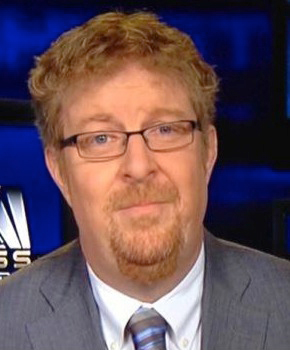
Steve Kretzmann (photo: Steve Kretzmann)
KRETZMANN: State Department has actually said there would be 35 - count them - 35 permanent jobs created by the Keystone XL pipeline. It did say they will be several thousand created in construction for the short-term, but if our goal is to meet our energy needs, and to create jobs, investing in solar, wind and alternative technologies are much more labor intensive way to do it than investing in existing infrastructure around the oil industry.
CURWOOD: Steve, how do you respond to the report’s finding that even if we, that is the United States, don’t build the Keystone XL, Canadians will use rail or find a way to pipe oil to China. I man, basically, that extracting oil from tar sands will go on regardless of what we in the United States might do?
KRETZMANN: First and foremost, we literally have pages of quotes from oil executives and financial analysts who study the industry talking about how important Keystone in particular is to their expansion. As for the other pipeline proposals, they’re meeting very stiff resistance. It’s actually a much shorter pipeline to go out to the west coast of Canada, but they didn’t choose that route they have solid opposition from First Nations. There's also pipeline that would go east. We’ve seen huge opposition to that in the eastern part of Canada and in Portland, Maine, where they’re really stepping up and saying they don’t want the pipeline going through there. And the rail question which the State Department really said, you know, they’ll get it out by rail, that it’s no big deal...it's really curious that they think that because the only reported numbers on how much it's costing to take to diluted bitumen down to the Gulf Coast, say it's costing about $31 a barrel...compare that to a pipeline which is about $8 or $9 dollars a barrel and you can see there is a clear financial incentive for the industry to build pipelines rather than rail.
CURWOOD: Steve Kretzmann, put this all in historical perspective for me. How important is the Keystone XL Pipeline case, do you think, in American history?
KRETZMANN: I think this is actually an absolute watershed campaign in the environmental movement in the United States. The reality is, the President’s going to have to make a choice - is it going to be the oil industry, or is it going to be saving the climate for future generations? We certainly believe and hope that he will make the right choice there.
CURWOOD: Steve Kretzmann is the Executive Director for Oil Change International. Thanks so much, Steve, for taking the time.
KRETZMANN: Thank you, Steve.
Related links:
- March 1, 2013 State Department briefing on supplemental Environmental Impact statement regarding Keystone XL
- Text of State Department’s Draft Supplementary Environmental Impact Statement (SEIS)
- Oil Change International’s statement on the State Department’s Keystone report
- Oil Change International website
- Inside Climate News article citing potential conflicts of interest by those who conducted the research that forms the basis of the State Department’s Draft Supplementary Environmental Impact Statement Linking the State Department report with pipeline companies
Canadian Government Gag Order for Scientists?
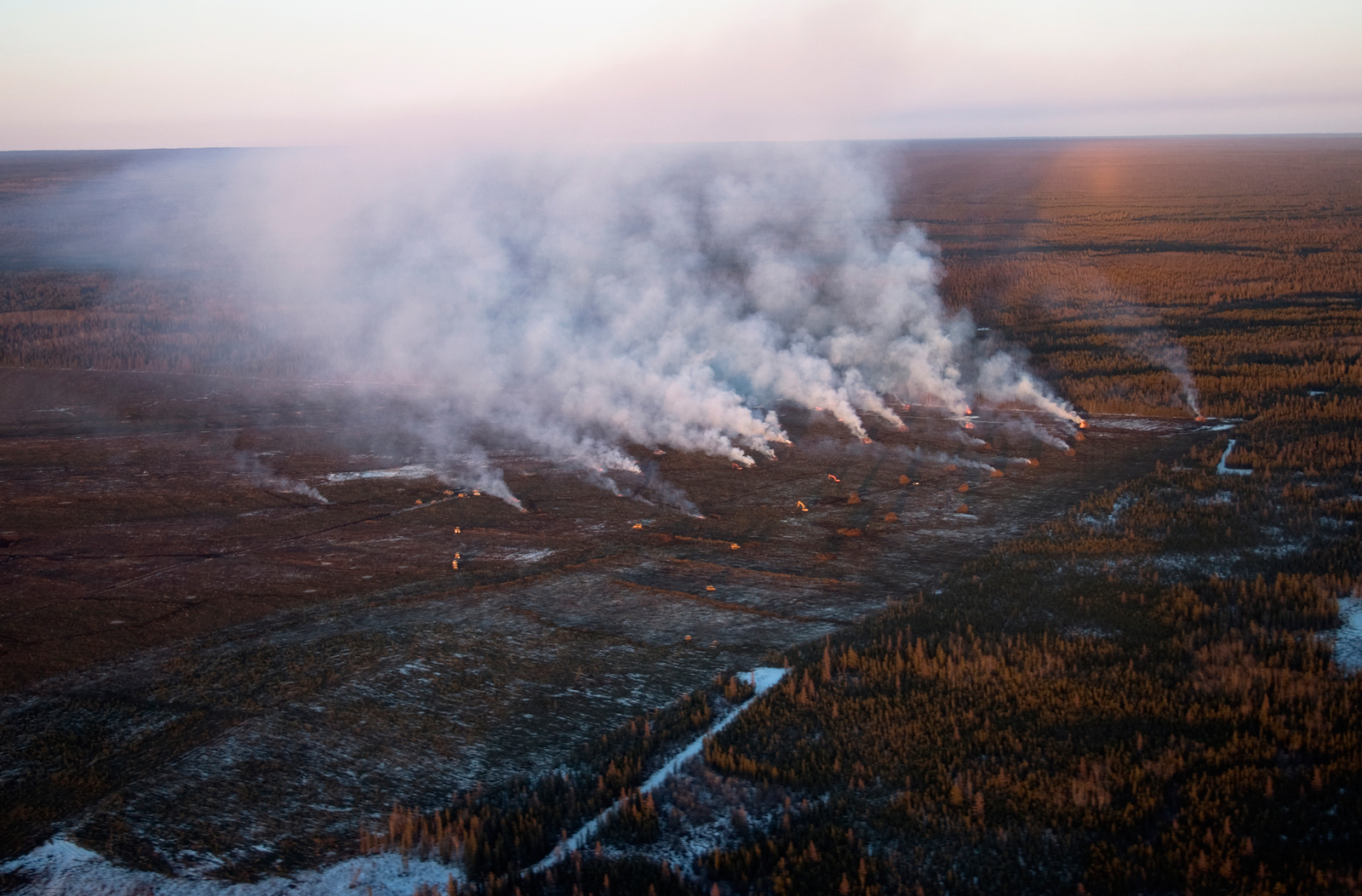
The Tar Sands of Alberta (Photo: bigstockphoto.org)
CURWOOD: Canada’s conservative government, which has been pressing the Obama Administration to approve the Keystone XL pipeline, has come under sharp criticism for allegedly muzzling Canadian government scientists who talk about the pipeline, climate change and other controversial topics. The Environmental Law Centre at the University of Victoria released a report called “Muzzling Civil Servants: A Threat to Democracy" that documents the ways in which Prime Minister Stephen Harper’s administration has prevented public scientists from speaking freely about their research. The Law Centre and Democracy Watch, a leading Canadian public accountability group, have requested an official inquiry into whether these practices violate Canada’s Open Government laws. Tyler Sommers is the Coordinator for Democracy Watch, and he joins us now. Welcome to Living on Earth.
SOMMERS: Hi.
CURWOOD: So what was the process for talking to government scientists before Prime Minister Harper took office, and what's it like now?
SOMMERS: Well, it was a much more relaxed situation. Journalists and sometimes even the general public were able to call and speak to scientists about their scientific research without much oversight of these conversations. But what we’ve moved toward now is a situation when journalists call to speak to scientists, the scientists need to speak to their supervisors, speak through communications officers, or even to the minister’s office to get approval to speak to these journalists about their scientific research. And sometimes this can be so specific as to require them to get approval of the very lines that they’re going to send to a journalist in response to whatever questions they have.

Tyler Sommers of Democracy Watch (photo: DemocracyWatch)
CURWOOD: Now what are the topics you found are being most muzzled?
SOMMERS: The topics where they’re seems to be more protection are the politically sensitive ones. So things like climate change, like salmon fisheries, resource extraction. But these aren’t communications policies that apply to all federal government scientists that were able to find in those departments. So there was a joint NASA and National Research Council study into snowfall patterns. So the journalist called NASA and was able to speak to a scientist and completely get through an entire process of reaching them, having a talk and hanging up within 15 minutes. They called our end to speak to the Canadian side of things, to find out what was going on, to find out what Canada’s involvement was, what the purpose was and what they found. It wasn’t really a politically sensitive topic. But because of the lengthy delay, they didn’t get back to the journalist until a day after the deadline, he decided he would file an access to information request and see what was going on. And they found 11 public servants with over 50 emails discussing the various points about his request. And one point that’s particularly troubling is the fact that they were discussing tone. Because what implies was that if the tone is positive, so if he was going to write something good about the government, or good about the department, they would be more likely to let him speak to a scientist. Or if the tone was negative, they would be less likely. And that’s particularly troubling because it at least implies that the government is trying to shape the information that federal government scientists release.
CURWOOD: So there are a number of cases that are cited in the Environmental Law Centre’s study. Could you talk about another one that’s particularly egregious?
SOMMERS: Sure, another example of the muzzling we uncovered...scientists who were attending the International Polar Year 2012 conference in Montreal - so this a conference that brings together scientists from all over Montreal - they were told when approached by a journalist that they should ask them for their business card and tell them that you would get back to them with a time for an interview. And then what they were to do was to speak to their media relations people in their department who would schedule and attend any interviews that these scientists went to. They also had media relations people follow these scientists at the conference in order to monitor what they were saying to journalists and record any conversations that they had.
CURWOOD: So in so far as you can tell, what do you think the government’s motive is in doing this?
SOMMERS: The government’s motive, as far as well can tell, is that they want to limit as much as possible any negative press. This is a government that ran on open government, that ran on cleaning up and making our country more democratic. And now we find that they’re limiting the information that Canadians pay for. So the reason we believe they’re doing is...they’re just trying to ensure that nothing that scientists release is counter to the government message.
CURWOOD: Now, your organization Democracy Watch and the authors from the Environmental Law Centre have written to Canada’s Information Commissioner - I believe her name is Suzanne Legault - asking her to investigate these policies. What do you expect will come out it?
SOMMERS: What we’re hoping will come out it is that she’ll launch a full investigation, and she’ll see whether this is a systemic issue or whether it’s isolated to mostly the cases that we found. But one thing that the Information Commissioner has said was, in contrast to some of the government lines that they’re the most open in Canadian history that they are far from that. And that providing information to the public isn’t increasing - it’s actually declining. And the amount of time that it’s taking for the public to get information is also increasing. And that’s one thing that we must consider and we must keep our eye on - is the fact that delay is a very useful tactic. If politicians are able to put off a story coming out, or information coming out until after the media has moved on and they’ve found something else to focus on, they may be able to avoid accountability and avoid responsibility by and large for whatever actions they have taken.
CURWOOD: I understand that some scientists have actually been holding demonstrations at Ottawa in front of Parliament on this issue?
SOMMERS: Yes, there have been a number of scientists that have come together in different ways. There was a Death of Science rally recently in Ottawa and on Parliament Hill, but the response from the science community has been the same. They said that the government and Canadians have somehow come to accept an iron curtain around scientific research is happening.
CURWOOD: Tyler Sommers is the Coordinator for Democracy Watch. Thank you so much for taking this time.
SOMMERS: Thank you for having me.
CURWOOD: We asked the Canadian government for comment, a statement from the Honorable Gary Goodyear, Minister of State (Science and Technology) is posted in full on our website LOE.org. It reads, in part: "The number of peer-reviewed articles, research reports and datasets that are made available by federal scientists each year stand as clear evidence of our government’s commitment to the scientific enterprise."
[FULL STATEMENT FROM GARY GOODYEAR
Good afternoon Qainat,
As discussed, please find below a statement from the Honorable Gary Goodyear, Minister of State (Science and Technologie) on the Environmental Law Centre at the University of Victoria's report called Muzzling Civil Servants:
It is important to keep in mind the sheer breadth and depth of federal scientists’ current activities. Our government employs and supports scientists and researchers in countless capacities.
In 2011-12, more than 20,000 scientific and professional personnel worked for the federal government, including nearly 7,000 engaged in research and development.
Their work encompasses a number of disciplines and fields, such as protecting us against unsafe products; working to better understand our environment including our bodies of water; helping us manage our natural resources responsibly; pushing the boundaries of human knowledge; and challenging our conventional understanding of nature and the very functioning of the universe.
The number of peer-reviewed articles, research reports and data sets that are made available by federal scientists each year stand as clear evidence of our government’s commitment to the scientific enterprise.
In all of this work, government scientists continue to engage Canadians regularly. Last year, Environment Canada participated in more than 1,300 media interviews and statistics showed that its scientists published 524 peer-reviewed journal articles in 2010. In the same year, Agriculture and Agri-Food Canada issued more than 968 scientific publications while Natural Resources Canada published 487. These are just a few examples of the numerous departments and agencies that actively share their research.
We value and support the work our scientists do each day and rely on the critical knowledge they produce to inform public policy and meet the needs of Canadians. The numbers show that not only does this government stand behind its scientists; we are making more of the data they generate available to Canadians than ever before. In our Canadian system, Ministers are the primary spokespersons for government departments.
Hon. Gary Goodyear
Minister of State (Science and Technology)]
Related links:
- Official request for enquiry
- Democracy Watch website
[MUSIC: Wes Montgomery “Movin Along” from Blue n’ Boogie: The Encores Vol. 2 (Milestone Records 1996) Happy Birthday Wes Montgomery (3/6/1923 – 6/15/1968) R.I.P. Melvin Rhyne (10/12/1936 – 3/5/2013)]
CURWOOD: Coming up...perhaps a new label for plastics. That's just ahead on Living on Earth.
ANNOUNCER: Funding for Living on Earth comes from the Grantham Foundation for the protection of the environment, supporting strategic communications and collaboration in solving the world’s most pressing environmental problems. The Gordon and Betty Moore Foundation. The Kendeda Fund, furthering the values that contribute to a healthy planet. And Gilman Ordway for coverage of conservation and environmental change. This is PRI, Public Radio International.
[CUTAWAY MUSIC: Jimi Hendrix: “Easy Blues” from People, Hell And Angels (Sony Music 2013)]
Road Salt Report

Extra salt left over from road clearing washes into nearby waterways during spring rains. (Photo: Chris Swan, University of Maryland, Baltimore County)
CURWOOD: It's Living On Earth, I'm Steve Curwood.
[SNOW TRUCK PASSING]
Winter just won't let up this year, and we keep piling on the salt.
[SPRINKLING OF SALT ON SIDEWALK]
CURWOOD: Over half the states in the Union apply salt to their roads and in fact, the United States Geological Survey reports that in 2011 nearly 20 million tons of salt were used to de-ice and keep our roads safe. But all that salt may not be so safe for our drinking water, or the environment. Not long ago reporter Ashley Ahearn headed out in a snowstorm to find out more.
[FOOTSTEPS ON PACKED SNOW, THEN SHOVELING SOUNDS]
AHEARN: When a recent nor’easter plastered the streets of Cambridge with white, Osiris Ochoa and Alcides Perez got to work.
[SHOVEL SCRAPING]
AHEARN: Are you guys putting salt on the sidewalk after?
OCHOA: Yes.
[SHAKING SALT]
OCHOA: I don’t know how good it is for the environment, but for the snow and the ice it’s pretty good.
AHEARN: Over 20 million tons of salt are used to clear U.S. roads each winter - far more than any other type of snow removal chemical or sand.
SWAN: It’s a lot of salt. It dissolves in water so it ends up as runoff in our streams and rivers or it ends up in the groundwater or it ends up stored in soils.

Professor Chris Swan of the University of Maryland, Baltimore County (photo: UMBC)
AHEARN: Chris Swan is an assistant professor in the Environmental Sciences department at the University of Maryland, Baltimore County.
SWAN: As that increases, we’re starting to see a rise in the average and peak salt concentrations in our drinking water.
AHEARN: One recent National Academy of Sciences study shows that salt concentration in fresh water is on the rise in Maryland, New Hampshire and New York due to road salting and could make groundwater in many areas of the Northeast un-drinkable within a century.
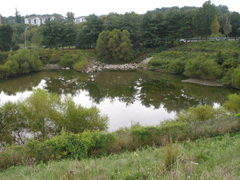
Storm water runoff ponds, like this one in the Red Run Watershed in Maryland, often have high levels of salt, affecting the pond’s ecosystem. (Photo: Robin Van Meter)
A new study from the University of Minnesota found salt levels on the rise in 39 lakes in the Midwest. Too much salt isn’t good for people or, says Chris Swan, for freshwater ecosystems.
SWAN: When you put an organism in a high salt environment it becomes stressed. We notice that when we eat salty foods, we notice that when we – say - go to the beach in the summer time, you become dehydrated.
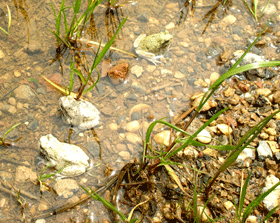
New research shows that road salt draining into nearby watersheds could be causing gray tree frogs to develop quicker and grow larger. (Photo: Robin Van Meter)
AHEARN: When Chris Swan exposed frogs to the same levels of salt found in semi-urban watersheds, he found they didn’t shrivel up and die. The salt changed the way the frogs developed.
SWAN: There’s something very odd going on. What we’re focusing on is the time it takes for them to go from egg to adults and we measure how large they are. And our initial studies are showing that they do that faster and when they do become adults they tend to be slightly larger than they are when they’re not exposed to salt.
AHEARN: Swan says the frogs exposed to salt feed much more intensely during development and this could make them easier prey in the wild, although it’s too soon to tell what this might mean for survival rates, or breeding. Amphibians are indicator species for freshwater ecosystems, but Swan says you’ve got to look to the smaller members of the aquatic food chain to get the big picture.
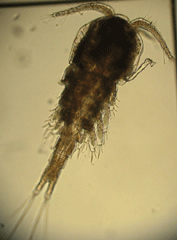
Zooplankton are an important food source for many fish, and suffer severely from exposure to salt. (Photo: Jennifer Li)
SWAN: Right now we’re showing that while we see these interesting effects on the frogs and the food that they eat, we’re also seeing the zooplankton being really negatively impacted.
AHEARN: Zooplankton...those are the tiny invertebrates that propel themselves around the water column, feeding on algae. If salt kills zooplankton, that’s not just going to mean more green scum on the water, it could also mean that larger predators, like the many species of fish that feed on zooplankton, go hungry.
[MUSIC - Chuck Berry, “Ridin’ along in my Automobile”]
AHEARN: Since the 40’s and 50’s highway agencies in the U.S. have operated under what’s called the “bare pavement” policy - doing whatever it takes to keep roads clear of snow and ice for motorists.
It’s about convenience. And perhaps no one knows that better than Brian Birch. He’s the Assistant Executive Director of the Snow and Ice Management Association. I called him up during a recent nor’easter.
[PHONE RINGING]
BIRCH: Hi, this is Brian.
AHEARN: Hey, Brian it’s Ashley.
BIRCH: Oh hi, Ashley, how are you?
AHEARN: Birch had been stuck in the Newark airport for the past three hours, but he was still willing to talk about the effects of salting roads.
BIRCH: In general the snow industry faces a big challenge balancing environmental concerns with public safety and transportation concerns.
AHEARN: So do you hate Mother Nature right now?
BIRCH: No I love it. This is...um...
AHEARN ON TAPE: How long have you been sitting in that airport, c’mon?
BIRCH: [LAUGHS] Well, um, it’s frustrating, I’m just like everybody else. Basically if you think about it, we live in a culture of convenience where we want to be able to go about our daily lives and be able to do anything we want to do even if it snowed eight inches outside.
AHEARN: As Birch said, snow removal is a critical public safety issue. Over 115,000 accidents happened under winter driving conditions in 2006. However, a growing number of scientists, like Chris Swan, are highlighting the effects of adding over 20 million tons of salt to the environment each winter, and they’re calling for smarter salting techniques.
Salt is still by far the cheapest and most readily available de-icer, but some cities and towns are looking into alternatives. Akron, Ohio uses beet juice as a de-icer and some towns in Connecticut and New York add high fructose corn syrup and molasses to their salt - all in the name of keeping winter roads safer for motorists and frogs alike. For Living on Earth, I’m Ashley Ahearn.
Related links:
- Professor Chris Swan's website
- The Center for Urban Environmental Research & Education at University of Maryland, Baltimore County
- Impacts of Road Deicing Salt on the Demography of Vernal Pool Breeding Amphibians
- Increased Salinization of Fresh Water in the Northeastern United States
- Accumulation of Deicing Salts in an Soils in an Urban Environment
[MUSIC: Equivel “Snowfall” from More Of Other Worlds, Other Sounds (Warner Bros 1962)]
The Hazards of Plastic Waste
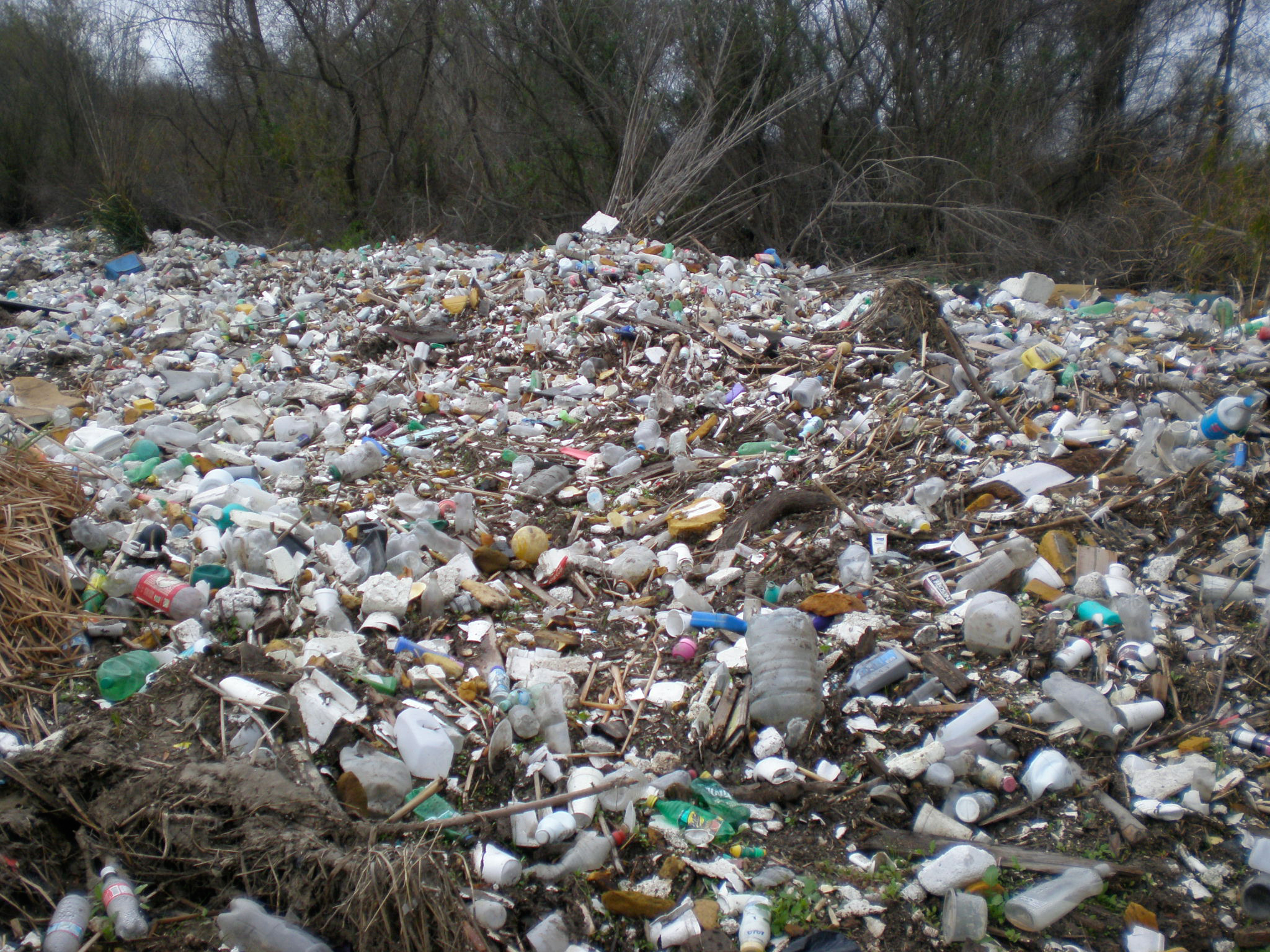
Plastic debris in the Tijuana River Valley in San Diego (photo: Chelsea Rochman)
CURWOOD: Every year, humans produce nearly 280 million tons of plastic. And much of that plastic ends up in the environment, harming marine life and other ecosystems. Now a group of scientists has a potential solution. Writing in Nature magazine, they argue that reclassifying plastics as hazardous waste would give regulators more tools and funding to clean the place up. One of the authors, Chelsea Rochman, a marine ecologist at the University of California at Davis, says it’s clear that plastics need a new label.
ROCHMAN: Waste is basically separated into two categories, those that are non-hazardous like grass clippings, and those that are considered a hazard, which are often based upon this long list of priority pollutants, or substances that the government deems are hazardous to organisms. And we found that plastics are associated with 78 percent of these priority pollutants listed by the US EPA and 61 percent listed by the European Union, either as a chemical ingredient of the plastic itself or when the plastic ends up in the aquatic environment; they absorb these contaminants from the water. And so from that perspective we thought maybe plastic as a waste product should also be considered as a hazardous substance.
CURWOOD: What's the danger?
ROCHMAN: We don't know an awful lot about the ecological hazards of plastics themselves. But we know a lot about the hazards associated with these priority pollutants. There's a vast amount of peer-reviewed literature on this. And so we know that these priority pollutants, when they get into food webs and into ecosystems, that they can cause harm at organism level, population level and so we’re concerned that if these plastics are another vessel for these priority pollutants to be getting into habitat, that they also may cause harm.
CURWOOD: Quickly, list for me the priority pollutants.

Chelsea Rochman looking for plastic at sea (photo: Stiv Wilson)
ROCHMAN: So, for the ones that are ingredients of plastics themselves...so styrene, which is the monomer for Styrofoam, vinyl chloride which is the monomer, the building block, for PVC, polyvinyl chloride, those are both considered priority pollutants. And they’re flagged as being carcinogenic - or potentially estrogenic for styrene. Some of the ones that are absorbing from the environment are things like toxic metals, like copper or lead, and pesticides such as DDT, that a lot of us are familiar with from the work of Rachel Carson. And PAHs which are maybe less familiar, but they’re an industrial byproduct that come from the combustion of oil, and a lot of them are considered either carcinogenic or they can cause harm to the reproduction system - depends on the chemical what their hazard is.
CURWOOD: So what are you recommending?
ROCHMAN: So what we’re recommending is to start off with a policy change that will enable a domino effect. So what we’re expecting first is that if we consider these plastics as a hazardous substance or hazardous once they end up in the environment, certain policies like in the US, for instance, CERCLA or Superfund, would be able to actually use funding to go in there and clean it up. So, for example, let's take the Hawaiian Islands where a lot of the plastic from the middle of the gyres, of the garbage patches are washing up. And so we know there’s large accumulations of plastic items on the beaches there. If plastics are considered a hazardous substance, the EPA then has legislation to go in and clean up that area and use funding and litigation to prevent further debris from accumulating.
CURWOOD: Let’s talk some numbers of plastics. How much plastic do we produce every year, and how much of it is not taken care of?
ROCHMAN: So at the moment, in 2011, we produced 280 million tons of plastic, and that’s globally. That same year, the World Bank reported that they collected in the waste stream, so they accounted for either in landfills or recycling, 130 million tons of plastic. So that leaves 150 million tons unaccounted for. Now obviously, some of that plastic is still on our feet as shoes or on our computers, in our houses, but not all of it can still be in use. So if you wonder where is that 150 million tons of plastic...and so we know there’s large accumulations in the environment. So I think that's troublesome because how much are we adding every year, and that’s the question we don’t know the answer to yet.
CURWOOD: Where is this worst? What ecosystems are being threatened by this?

More plastic debris in the Tijuana River Valley (photo: Chelsea Rochman)
ROCHMAN: Unfortunately at the moment we don't know. We still need a lot of research to determine this. The areas where we find a lot of plastic debris are, of course, we hear a lot about it in the middle of the open ocean; but there’s a lot of it near the coasts. So what I would argue is that your coastal ecosystems is probably where we want to concentrate because that's where we have the largest accumulations of these pollutants in the water which could potentially store to this plastic as it enters the water. And so we find plastics in these coastal ecosystems that are near urban areas that are gonna be associated with large concentrations, of say pesticides and the PAHs I talked about earlier and toxic metals.
CURWOOD: So you remember famously in the movie The Graduate, Dustin Hoffman is told, “Plastics, young man, plastics.” So what would we tell Dustin Hoffman today, his character? What would we replace plastic with?
ROCHMAN: I am so happy that you asked that question. It used to be how we began and ended the paper. So there’s a famous line in that movie that says, “plastics are the future”, right, or “the future is plastics”? And I would say that that’s not necessarily untrue. I still think there is a great future in plastics. And I don’t think plastics are evil and that we should ban them all, but I think we should start thinking about making plastic materials that are benign by design, and use our innovation strategies to make products that are recyclable, reusable and durable, and that are safe for people and the planet.
CURWOOD: Chelsea Rochman is a marine ecologist who studies toxicology at the University of California at Davis. Thank you so much.
ROCHMAN: Thank you.
Related links:
- The original commentary article
- Chelsea Rochman’s webpage at SDSU
[MUSIC: Funky Seeds “Plastic People” from Germination (Five Hats Productions 2010)]
The Cardinal's Growing Range

A male cardinal on the edge of the Neck River Marsh, Madison CT (photo: Mark Seth Lender)
CURWOOD: Throughout Rome, Catholic cardinals in their scarlet vestments have been sighted as they gather to choose a new Pope. And throughout New England, the bird that shares their name has become a commonplace sight, as climate change has extended its range. But as writer Mark Seth Lender recalls, that wasn't always the case.
LENDER: The Cardinal points his voice toward North (Coloratura, then Recitativo) in the red bud maple rush of spring when all the small and not yet green shoots upward, from hard winter ground. He finds (by a navigation no one knows) a place to build a nest; he calls his own, his love to lay her perfect eggs and sit with him there. He sings the sun to its pivot point then quiets down, a pause to mark beginnings, and one to mark the end. In fall, towards dusk, when cold clothes the rising moon in an icy throw and every leaf has gone, he sings again, that the young he fathers come to understand the words a Cardinal knows.
When I was a child - never saw him. Not one. Not once. Except for the picture book where C was not Cat not Cup not Car - C was for Cardinal, Phoenix red somewhere beyond the confine of a child’s four walls. Not ‘til my teens did I catch that flash of voice, that blur among the branches of a tree-lined street (long before Cardinal’s rare flame became a year-round commonplace - never commonplace to me).
Cardinal, timid to the light, prefers the almost dark of dawn, the end of color at the dropping down of night. Behind the curtain of the shortest day familiar notes ring out when Cardinal dreams, perhaps like me, of journeys not yet made, and mountains not yet crossed, of molten desert sands, and the slinking edge of permafrost.
[BIRDS CHIRPING – ROBIN, CARDINAL, RED-WINGED BLACKBIRD]
CURWOOD: Mark Seth Lender made this recording at Hammonasset Beach State Park in Madison, Connecticut. There's a Robin, and a Cardinal, and then a Red-Winged Blackbird. Mark's book is Salt Marsh Diary.
Related links:
- Mark Seth Lender’s website
- Mark’s book: Salt Marsh Diary: A Year on the Connecticut Coast
CURWOOD: Living on Earth is produced by the World Media Foundation. Naomi Arenberg, Bobby Bascomb, Emmett Fitzgerald, Qainat Khan, Helen Palmer, Adelaide Chen, James Curwood, and Gabriela Romanow all help to make our show. Jeff Turton is our technical director. Alison Lirish Dean composed our themes. You can find us anytime at LOE.org, and check out our Facebook page, it’s PRI’s Living on Earth. And we tweet from @LivingOnEarth. I'm Steve Curwood. Thanks for listening.
ANNOUNCER: Funding for Living on Earth comes from Stonyfield Farm, makers of organic yogurt, smoothies, and more. Stonyfield invites you to just eat organic for a day. Details at justeatorganic dot com. Support also comes from you our listeners. The Go Forward Fund and Pax World Mutual and Exchange Traded Funds, integrating environmental, social and governance factors into investment analysis and decision making. On the web at Pax World dot com. Pax World, for tomorrow.
ANNOUNCER 2: PRI Public Radio International.
Living on Earth wants to hear from you!
Living on Earth
62 Calef Highway, Suite 212
Lee, NH 03861
Telephone: 617-287-4121
E-mail: comments@loe.org
Newsletter [Click here]
Donate to Living on Earth!
Living on Earth is an independent media program and relies entirely on contributions from listeners and institutions supporting public service. Please donate now to preserve an independent environmental voice.
NewsletterLiving on Earth offers a weekly delivery of the show's rundown to your mailbox. Sign up for our newsletter today!
 Sailors For The Sea: Be the change you want to sea.
Sailors For The Sea: Be the change you want to sea.
 The Grantham Foundation for the Protection of the Environment: Committed to protecting and improving the health of the global environment.
The Grantham Foundation for the Protection of the Environment: Committed to protecting and improving the health of the global environment.
 Contribute to Living on Earth and receive, as our gift to you, an archival print of one of Mark Seth Lender's extraordinary wildlife photographs. Follow the link to see Mark's current collection of photographs.
Contribute to Living on Earth and receive, as our gift to you, an archival print of one of Mark Seth Lender's extraordinary wildlife photographs. Follow the link to see Mark's current collection of photographs.
 Buy a signed copy of Mark Seth Lender's book Smeagull the Seagull & support Living on Earth
Buy a signed copy of Mark Seth Lender's book Smeagull the Seagull & support Living on Earth

